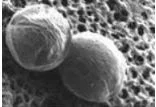Campylobacteriosis is an infectious disease caused by C. jejuni. It is also referred to as Campylobacter enteritis or gastroenteritis. Most cases of C. jejuni are sporadic (appearing singly or at widely scattered places) or involve small family groups, although some common-source outbreaks involving many people have been recorded. It is believed that consuming less than 500 cells can cause illness.
Cholera
Cholera is an acute diarrheal illness caused by infection of the intestine with the bacteria Vibrio cholerae. Cholera was prevalent in the 1800s, but due to proper treatment of sewage and drinking water, has become rare in developed countries. V. cholerae can be found in contaminated food or water, especially in areas of poor sanitation and water treatment.
Coxsackie B Virus
The Coxsackie virus was first isolated in Coxsackie, New York in 1948. There are six different Coxsackie B viruses, each responsible for different symptoms and diseases. Coxsackie B viruses are responsible for numerous cases of central nervous system infections in infants and children, as well as heart muscle infections in both children and adults.
Cryptosporidium
Cryptosporidiosis is a severe diarrheal disease caused by a microscopic parasite, Cryptosporidium parvum, abbreviated C. parvum. It (C. parvum) lives in the intestinal tracts of people and a wide variety of animals, and is transmitted when people or animals ingest food or water that it has contaminated. Cryptosporidium is a protozoan parasite.
Escherichia Coli
Escherichia coli, abbreviated E. coli, is a bacterium that is found in the large intestine or feces of healthy warm-blooded animals and humans. Most E. coli strains are harmless and serve a useful function in the body by stopping the growth of harmful bacteria species and by making necessary vitamins.
Giardia
Helicobacter Pylori
Helicobacter pylori (H. pylori) are a type of intestinal bacteria that cause the majority of ulcers in the stomach and duodenum. They thrive in highly acidic environments and have a unique way of adapting to the harsh environment of the stomach. H. pylori have been classified as low-potential carcinogens (cancer-causing substances) by the World Health Organization.
Hepatitis A
Hepatitis is the name for several different illnesses all caused by an inflammation of the liver. Drinking alcohol and taking drugs can cause hepatitis, but it can also be caused by a viral infection. Hepatitis A is a disease caused by the Hepatitis A Virus (HAV). It is the most common type of hepatitis, with at least 1.4 million reported cases world wide every year.
Legionella
Shigella
Detailed Campylobacter
Detailed Cryptosporidium
Detailed Escherichia Coli
Escherichia coli, also referred to as E. coli, is a type of fecal coliform bacteria that is found in the intestines of healthy warm-blooded animals and humans. Most E. coli strains are harmless and serve a useful function in the body by stopping the growth of harmful bacteria species and by making necessary vitamins. However, some strains can be opportunistic pathogens, while others can cause gastrointestinal illness in healthy humans when ingested.


















